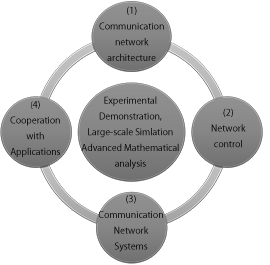Introduction

Mission Statement
Research Overview
Broadband access is progressing throughout the world and as a result, the amount of traffic is increasing rapidly. In accordance with the advances in ubiquitous networking, mobile Internet, and peer-to-peer networking, traffic characteristics will become more and more diversified; therefore, network technologies that can cost-effectively manipulate the burgeoning traffic must be developed. The network must be able to adapt to dynamic traffic changes and maintain a high reliability level to be a part of the infrastructure of our information society. High resiliency against disasters and a high security level are other important attributes to be achieved. The research target of our laboratory is to create the most effective information transfer mechanisms that support future bandwidth intensive applications, develop methods of effectively managing and controlling vast amounts of traffic that have a wide variety of traffic characteristics, and seek innovative transport mechanisms that make the best use of the inherent benefits of light. We aim to create simple but scalable networks that will be a new paradigm for the future. High-speed and large bandwidth photonic networks, new communication protocols with enhanced flexibility, and highly reliable network architectures are also included within our study items. Development of new analytical methods, large-scale simulation experiments using real network models, and development of prototype systems for next generation communication networks are a part of our activities. Through these endeavors, laboratory members are stimulated to play an active part in the world. The subjects of our research include the following:
・ Photonic IP networks design issues
・ Reliable network design against network failures
・ Photonic burst transport that takes advantage of the inherent nature of light
・ Traffic engineering technologies concerning multi-layer (electrical/optical) networks
・ Traffic control in and the optimization of core and edge networks
・ Network functions that maximize cooperation between network appliances and users, and among multiple users
・ Traffic characterization of new broadband services envisaged for the future
・ Next generation IP networks
・ Communications protocols
・ Network technologies that maximize the performance of applications
Research Items - from Hardware to Software, and Analysis -

Large-scale Network Design, Reliable Network Design against Network Failures, Optical Path/Flow/Burst Communication, etc.
(2) Network ControlPrediction of IP Traffic, Adaptive Network Control, Next-Generation Protocol, etc.
(3) Communication Network SystemsOptical Switch, Optical Cross-Connect, Advanced Optical Devices, etc.
(4) Cooperative ApplicationsCooperative Applications